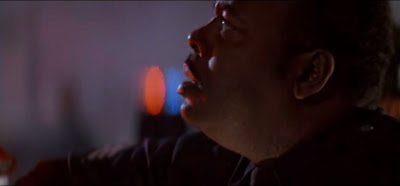Live Free or Die Hard aka Die Hard 4.0 (2007) is the return of John McClane after a fifteen year absence.
Overall
We start off with a sexy woman at a computer receiving downloads from several hackers. We then see one of them getting killed and it shows that each of the others has been "deactivated" on her screen. The CIA Cyber Terrorist unit then gets shut down and reboots. The feds want all the possible suspects questioned. We cut to John McClane threatening his daughter's date. After she gets pissed at him and storms off, John is ordered to pick up Matthew Farrell, one of the hackers from the intro. Once he arrives they are fired at and an action scene ensues.
This film was released to some stellar reviews with some calling it better than the original. I wholeheartedly disagree. This film returns to the holiday theme, in this case the Fourth of July, though much like Die Hard 2 it doesn't do much with it. Internationally this theme was disguised a bit. This film, like many resurgent sequels in the 2000s, goes bigger and more insane. The stability of the eastern U.S. is but in jeopardy thanks to a big cyber attack. Of course, since one of my favorite things was the simplicity of the first film, I dislike this a lot. Things are amped up from the very first fight scene and escalate to the ridiculous with the fighter jet versus big rig scene. Honestly, I had a hard time caring about these massive overblown and unrealistic scenes.
 Our Heroes
Our HeroesJohn McClane has gotten old and kind of creepy. In the first scene he spies on his teenage daughter. Creepy. Had he really been watching the whole date? Or did he just show up at the end to make sure nothing happened? Does he do that often? Anyway, Bruce Willis puts in a good performance, but he is getting old. he also survives some things that I don't think he would have been able to even nineteen years earlier during the first film.
 Matthew Farrell is your typical nerdy computer hacker. He's anti establishment to the point of being kind of annoying. He does "man up" over the course of the film and I was likeable by the end. He's best when bonding with John. He becomes more funny and less of a pain in the ass as he and John both learn from each other. His romance with Lucy comes out of nowhere at the end and is a little bit creepy given the comparisons he draws between her and her father. Ah, true love.
Matthew Farrell is your typical nerdy computer hacker. He's anti establishment to the point of being kind of annoying. He does "man up" over the course of the film and I was likeable by the end. He's best when bonding with John. He becomes more funny and less of a pain in the ass as he and John both learn from each other. His romance with Lucy comes out of nowhere at the end and is a little bit creepy given the comparisons he draws between her and her father. Ah, true love. Adorable Observer
Adorable ObserverLucy Gennero-McClane is John's daughter all grown up. She has some unspecified reasons for hating him that may stem from his weird stalking. behavior. She shines the most when she's being a tough girl and with more development she could have her own action series. She's also really cute in this role. They tried their hardest to make her really sexy and flirty at the start, but I just thought she came off as the cute girl next door. She definitely should have had more of a role through the middle of the story since her relationship with her father is a key point. I would have liked to know what happened between her and her father that caused her to take her mother's maiden name (seems like it should be something really big).
 Psychotic Foes
Psychotic FoesThomas Gabriel is a truly psychotic hacker (and he doesn't have to do Ty-chi naked to get it across). The only problem with this is that he's too psychotic. He's so unrelatable with such crazy motives that I didn't find him interesting. He was menacing, yet boring. At least he had some personality though.
Mai Linh is a sexy Asian ninja hacker. Yep. She is there to look good and fight. That's what she does. Personality? Not really. Oh, and she's Gabriel's girlfriend or something.
Explosive Atmosphere
This movie has more explosions that the past three films put together. There's also more martial arts and the usual action hero beats martial artist with ingenuity thing. The sets do look great, but the action was too big and ridiculous.
In the End
The end fight was pretty awesome and I wish the rest of the movie would have been as plain badass as the end. It hits all the right notes and gives the characters a good send off.
Overall
Live Free or Die Hard is just too overblown and flashy for me. The story wasn't bad, but it focused on action rather than character. That's a shame because the characters were entertaining and likeable. I can see why a lot of people like this installment. I just think this too big. Give me a simple character driven film any day. So it's not bad, but not terribly good. Check this out if you like bigger and more ridiculous action scenes with solid characters. "Yippie Ki-Yay Mother F-----" Oh and Live Free is PG-13!
6.5/10
Well that's it. That's the whole series...
Except the one coming out next year. So I'll be back in a month and a half and I'll see if it is A Good Day to Die Hard.









































